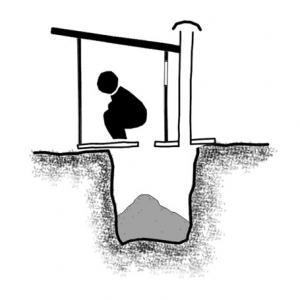The single VIP is a ventilated improved pit. It is an improvement over the single pit because continuous airflow through the ventilation pipe vents odours and acts as a trap for flies as they escape towards the light. Yet, the single VIP remains among the simplest and cheapest toilet systems. Thus, the danger of groundwater contamination due to soil infiltration persists, especially in densely populated areas.
| المُدخلات | المُخرَجات |
|---|---|
Urine, Faeces, Excreta, Blackwater, Anal Cleansing Water, Dry Cleansing Material |
Sludge |
The design of a VIP is nearly the same as a normal pit latrine – made of a superstructure, a pit cover slab and a hole for defecation – and can be used both for single and double pits. Different is only the ventilation pipe, provided with a durable fly screen on the top (SANIMAS 2005). Despite their simplicity, well-designed single VIPs can be completely smell free, and more pleasant to use than some other water-based technologies.
Flies that hatch in the pit are attracted to the light at the top of the ventilation pipe. When they fly towards the light and try to escape, they are trapped by the fly-screen and die. The toilet superstructure must be kept sufficiently dark, so that the flies leave the pit through the pipe and not through the squat hole into the toilet. The ventilation also allows odours to escape and minimizes the attraction for flies. A small gap above the door or a louvre in the door allows the air to enter. The flow of air is increased if the doorway of the superstructure faces the prevailing wind (WHO 1992).
The VIP needs no water for its function. This is a big advantage in water scarce areas in comparison with flush toilets (see flush toilets, pour flush toilets or low-flush toilets. However, compared to toilet systems such as UDDTs, composting toilets, twin-pits for pour flush, terra preta toilets, arborloo or fossa alterna), the treatment processes are limited (EAWAG/SANDEC 2008).
The vent pipe should have an internal diameter of at least 110 mm and reach more than 300 mm above the highest point of the toilet superstructure. It can be made out of PVC, bricks, pet bottles or iron pipes. Wind passing over the top creates a suction pressure within the vent pipe and induces an air circulation. Air is drawn through the user interface into the pit, moves up inside the vent pipe and escapes into the atmosphere. Care should be taken that objects, such as trees or houses, do not interfere with the air stream. The vent works best in windy areas, but where there is little wind, its effectiveness can be improved by painting the pipe black. The heat difference between the pit (cool) and the vent (warm) creates an updraft that pulls the air and odours up and out of the pit. To test the efficacy of the ventilation, a lit cigarette can be held over the user interface; the smoke should be pulled down into the pit and up into the vent and not remain in the superstructure.
The mesh size of the fly screen must be large enough to prevent clogging with dust and allow air to circulate freely. Aluminium screens, with a hole-size of 1.2 to 1.5 mm, have proven to be the most effective. Typically, the pit is at least 3 m deep and 1 to 1.5 m in diameter, depending on the number of users. Deep pits can last up to 20 or more years. The longer a pit lasts, the lower will be the average annual economic cost and the greater the social benefits from the original input (WHO 1992).
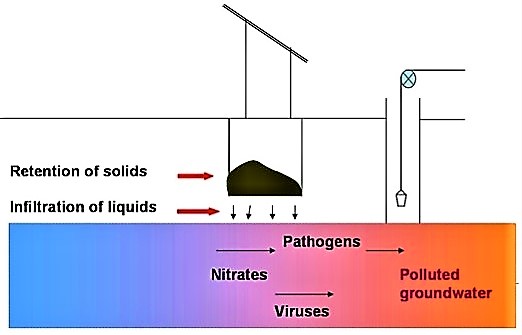
As liquid leaches from the pit and migrates through the unsaturated soil matrix, pathogenic germs are sorbed to the soil surface. In this way, pathogens can be removed prior to contact with groundwater. The degree of removal varies with soil type, distance travelled, moisture and other environmental factors and, thus, it is difficult to estimate the distance necessary between a pit and a water source. A minimum horizontal distance of 30 m between a pit and a water source and 2 m between the bottom of the pit and the groundwater table is normally recommended to limit exposure to microbial contamination. In densely populated areas with many pit latrines it is often not possible to keep these distances between pollution sources and water abstraction points due to very limited space. In these areas, the risk of groundwater contamination remains extremely high, representing important health risks for the communities.
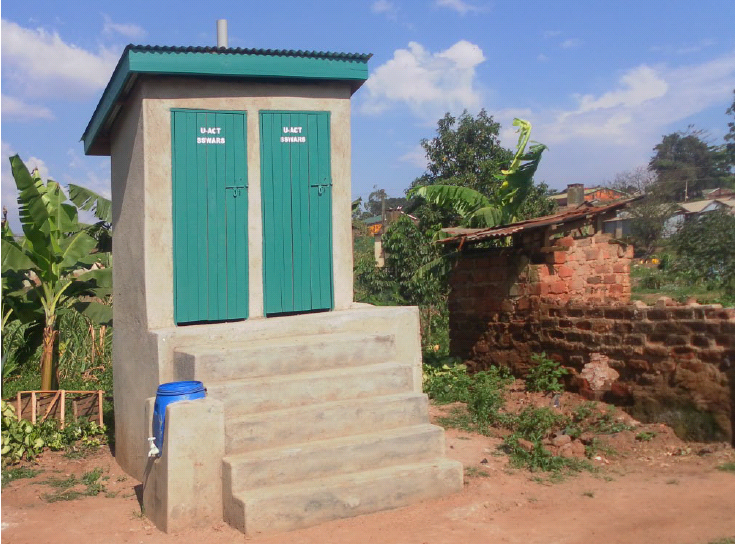
When it is not possible to dig a deep pit or the groundwater level is too high, a raised pit can be a viable alternative: the shallow pit can be extended by building the pit upwards with the use of concrete rings or blocks. A raised pit can also be constructed in an area where flooding is frequent in order to keep water from flowing into the pit during heavy rain. Urine diverting dry toilets (UDDTs) could also be a suitable option for regions with high groundwater table, as they are generally built above ground. In regions which tend to get flooded, “hanging UDDTs” are recommended.
A single VIP toilet can be upgraded to a double VIP. A double VIP has an extra pit so that while one is in use, the contents of the full pit are allowed to drain, mature and degrade. Once they are matured, it can be composted and can then be reused in agriculture (see also use of compost).
If a urine-diverting user interface (see urine diversion slab) is used, only faeces are collected in the pit and leaching can be minimized. The separately collected urine can be stored and reused it in agriculture. Once the faecal sludge is composted, it may also be reused in agriculture.
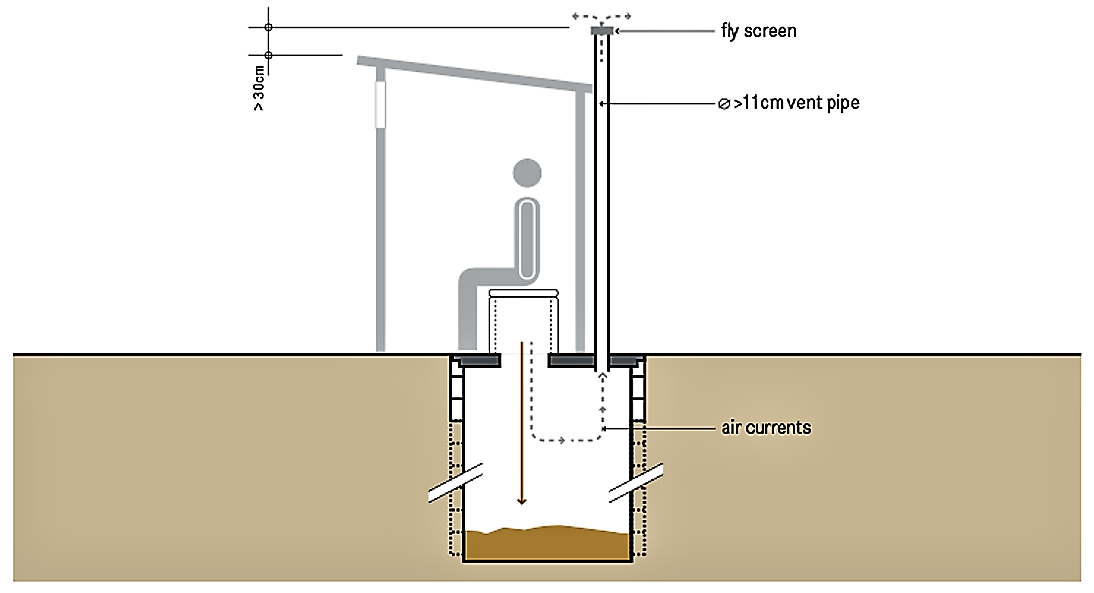
A single VIP can be a very clean, comfortable, and well accepted sanitation option. However, some health concerns exist:
- Leachate can contaminate groundwater;
- Pits are susceptible to failure and/or overflowing during floods;
- Health risks from flies are not completely removed by ventilation.
The emptying (see invalid link and motorised) of pit latrines containing fresh excreta presents problems because of the active pathogens in the sludge. Manual removal should therefore be avoided (WHO 1992).
VIPs are slightly more expensive than normal pit latrines. The construction needs some extra material (e.g. the vent pipe) and it should be noted that a ventilated design needs a roofed and darkened superstructure. Furthermore, costs for emptying the pits (see invalid link and motorised) need to be considered. It should not be a problem, however, to build de VIP with local material (WHO 1992).
To keep the single VIP free of flies and odours, regular cleaning and maintenance is required. This will also prevent the spread of pathogens (see also invalid link). Dead flies, spider webs, dust and other debris should be removed from the ventilation screen to ensure a good flow of air. When the pit is full it can either be emptied to treat and reuse the sludge (see also composting or use of compost) or the superstructure and squatting plate can be moved to a new pit. In the latter case, the old pit is covered and decommissioned, which is only advisable if plenty of land area is available. If the superstructure can be moved to a new pit, after several years, the decomposed sludge in the former pit will not cause any health problems and can be dug out without any objectionable smell. The sludge can then be used directly as a fertilizer (see also use of compost in agriculture).
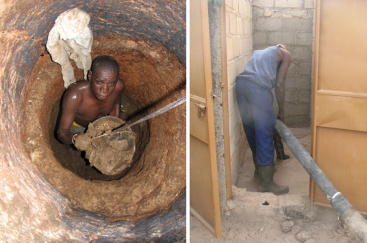
| Working Principle | A ventilated improved pit latrine (VIP) is similar to a single pit latrine with addition of a vertical vent pipe. Through the aeration in VIPs, odour and fly nuisances are reduced. Excreta, along with anal cleansing materials (water or solids) are deposited into a pit. Lining the pit prevents it from collapsing and provides support to the superstructure. |
| Capacity/Adequacy | The VIP is designed for rural and peri-urban areas. It is simple to build and can be constructed by the user itself with locally available material. |
| Performance | The treatment processes of the faecal material in the pit are limited and stagnant water may promote insect breeding. |
| Costs | Low-cost |
| Self-help Compatibility | Can be built and repaired with locally available material. It must be maintained correctly and well-kept. |
| O&M | Apart from keeping it clean, there is no daily maintenance associated with a VIP. The vent pipe should be cleaned periodically to prevent clogging. |
| Reliability | If well maintained and constructed, the excreta is at least collected in the pit and risks of infections are lower. |
| Main strength | No water required; excreta is collected; odours and fly nuisance are reduced compared with a simple pit latrine. |
| Main weakness | There is danger of groundwater contamination, because of soil infiltration (especially in densely populated areas). |
Treatment processes in the single VIP (aerobic, anaerobic, dehydration, composting, or otherwise) are limited, and, therefore, pathogen reduction and organic degradation is not significant compared to composting or dehydration toilets. Moreover, due to infiltration, the risk of groundwater contamination is high . However, since the excreta are contained, pathogen transmission to the user is limited. This technology is a significant improvement over single pits or open defecation.
Single VIPs are appropriate for rural and peri-urban areas; in densely populated areas they are often difficult to empty and/or have insufficient space for infiltration. VIPs are especially appropriate when water is scarce and where there is a low groundwater table. Depending on the pit depth, depth to the water table, number of users and soil conditions, some pits can be used for 20 years without emptying. They should be located in an area with a good breeze to ensure effective ventilation. They are not suited for rocky or compacted soils (that are difficult to dig) or for areas that flood frequently. For areas where digging is difficult, the Arborloo could be a suitable option. As an alternative for regions with high groundwater table or frequent flooding, Urine diverting dry toilets could be considered.
Sanitation Systems and Technologies. Lecture Notes
Lecture notes on technical and non-technical aspects of sanitation systems in developing countries.
EAWAG/SANDEC (2008): Sanitation Systems and Technologies. Lecture Notes . (= Sandec Training Tool 1.0, Module 4 ). Duebendorf: Swiss Federal Institute of Aquatic Science (EAWAG), Department of Water and Sanitation in Developing Countries (SANDEC)Ventilated Improved Latrine Construction in the Slum Areas of Kampala, Uganda
The Urban Affordable Clean Toilets (U-ACT) project aims at overcoming the constraints to private sanitation investment in poor urban areas. Field research was conducted in 40 randomly selected low-income areas of Uganda’s capital Kampala where people rely on on-site sanitation. The sanitation situation in these urban slum zones is characterised by a high number of users per toilet, and full or overflowing latrines that are not regularly emptied. This factsheet provides information on the construction and cost details of ventilated improved pit (VIP) latrines.
LUETHI, C. NIWAGABA, B.C. GUENTHER, I. HORST, A. MULONGO, P. GRUETER, R. (2013): Ventilated Improved Latrine Construction in the Slum Areas of Kampala, Uganda. Technical Factsheet. Zuerich: Nachdiplomstudium fuer Entwicklungslaender (NADEL) Eidgenoessische Technische Hochschule (ETH) URL [Accessed: 10.10.2013]The design of Ventilated Improved Pit Latrines
The purpose of this paper is to discuss general design criteria for VIP latrines and to review recent developments in VIP latrine design.
MARA, D.D. (1984): The design of Ventilated Improved Pit Latrines. UNDP Interregional Project. (= United Nations Development Programme Interregional Project , 47 ). Washington: The World Bank URL [Accessed: 11.10.2013]Low-cost Urban Sanitation
This book covers the public health, technical, socioeconomic, sociocultural and institutional aspects of sanitation in towns and cities of developing countries. The text features excreta-related diseases and the use of sanitation to reduce their transmission. The sanitation technologies covered in detail are VIP latrines, pour-flush toilets, septic tanks, settled sewerage and simplified sewerage, with additional chapters on sullage disposal, pit emptying, and sewage treatment and reuse. Sociocultural constraints on sanitation systems and their socioeconomic costing are described, together with hygiene education, which is essential in order to achieve maximum benefits to health. The text also explains how to choose the most appropriate sanitation option for a given low-income community. Finally, institutional aspects are reviewed, including effective sanitation programme planning, monitoring and evaluation.
MARA, D. (1996): Low-cost Urban Sanitation. United Kingdom: WileyEcological Toilets
This book describes how to construct Arborloo toilets and how it can be upgraded to VIPs at a later stage.
MORGAN, P. EcoSanRes (2009): Ecological Toilets. (pdf presentation). Stockholm: Stockholm Environment Institute URL [Accessed: 09.05.2019]The Upgradeable Blair VIP
This manual provides detailed design and construction information on the Blair VIP toilet.
MORGAN, P.P. (2011): The Upgradeable Blair VIP . Manual for upgradeable BVIP model with spiral superstructure and tubular vent. Stockholm: Stockholm Environment Institute (SEI) URL [Accessed: 31.01.2014]Ventilated Improved Pit Latrines: Vent Pipe Design Guidelines
This technical note sets out preliminary guidelines for the design and construction of vent pipes for ventilated improved pit (VIP) latrines.
RYAN, B.A. MARA, D.D. (1983): Ventilated Improved Pit Latrines: Vent Pipe Design Guidelines. (= UNDP Interregional Project INT/81/047 ). Washington: The World Bank, United Nations Development Programme (UNDP) URL [Accessed: 31.01.2014]Informed Choice Catalogue
This informed choice catalogue for community based wastewater treatment technologies helps to identify suitable sanitation options and facilitates the assessment of different sanitation system components with regard to stakeholder preferences. A powerful tool for technical bottom-up planning giving overall information about technical options at a "glance".
SANIMAS (2005): Informed Choice Catalogue. pdf presentation. BORDA and USAID URL [Accessed: 29.05.2019]Compendium of Sanitation Systems and Technologies
This compendium gives a systematic overview on different sanitation systems and technologies and describes a wide range of available low-cost sanitation technologies.
TILLEY, E. LUETHI, C. MOREL, A. ZURBRUEGG, C. SCHERTENLEIB, R. (2008): Compendium of Sanitation Systems and Technologies. Duebendorf, Switzerland: Swiss Federal Institute of Aquatic Science and Technology (EAWAG) and Water Supply and Sanitation Collaborative Council (WSSCC) URL [Accessed: 15.02.2010] PDFCompendium of Sanitation Systems and Technologies. 2nd Revised Edition
This compendium gives a systematic overview on different sanitation systems and technologies and describes a wide range of available low-cost sanitation technologies.
TILLEY, E. ULRICH, L. LUETHI, C. REYMOND, P. ZURBRUEGG, C. (2014): Compendium of Sanitation Systems and Technologies. 2nd Revised Edition. Duebendorf, Switzerland: Swiss Federal Institute of Aquatic Science and Technology (Eawag) URL [Accessed: 28.07.2014] PDFA Guide to the Development of On-site Sanitation
The publication presents appropriate technologies for sanitation and highlights socio-economic aspects of planning and implementing. Emphasis is given to household-level sanitation improvements for urban areas, as well as rural areas and small communities. Background information on sanitation, in-depth technical information on the design, construction, operation and maintenance and project planning and development processes involved in projects and programmes complement the book.
WHO (1992): A Guide to the Development of On-site Sanitation. Geneva: World Health Organisation (WHO) URL [Accessed: 14.04.2010]Compendium of Sanitation Systems and Technologies (Arabic)
This is the Arabic version of the Compendium of Sanitation Systems and Technologies. The Compendium gives a systematic overview on different sanitation systems and technologies and describes a wide range of available low-cost sanitation technologies.
TILLEY, E. ULRICH, L. LUETHI, C. REYMOND, P. SCHERTENLEIB, R. ZURBRUEGG, C. (2014): Compendium of Sanitation Systems and Technologies (Arabic). 2nd Revised Edition. Duebendorf, Switzerland: Swiss Federal Institute of Aquatic Science and Technology (Eawag) PDFGuidelines for Assessing the Risk to Groundwater from On-Site Sanitation
Many people in developing countries rely upon untreated groundwater supplies for their drinking water (e.g. from drilled boreholes, tube wells, dug wells or springs). The introduction of on-site sanitation systems might lead to groundwater contamination. The purpose of this manual is to provide guidance on how to assess and reduce the risk of contamination of groundwater supplies from on-site sanitation systems and is aimed at those responsible for planning low cost water supply and sanitation schemes.
ARGOSS (2001): Guidelines for Assessing the Risk to Groundwater from On-Site Sanitation. (= Commissioned Report , 142 ). Keyworth: British Geological Survey URL [Accessed: 11.05.2019]Latrine Building
Sanitation Systems and Technologies. Lecture Notes
Lecture notes on technical and non-technical aspects of sanitation systems in developing countries.
EAWAG/SANDEC (2008): Sanitation Systems and Technologies. Lecture Notes . (= Sandec Training Tool 1.0, Module 4 ). Duebendorf: Swiss Federal Institute of Aquatic Science (EAWAG), Department of Water and Sanitation in Developing Countries (SANDEC)Faecal Sludge Management.
This issue presents studies from different regions (Bangladesh, Cameroon, Burkina Faso) that mainly show the non-existence of faecal sludge management. Additionally, the last paper describes a new technological solution (LaDePa) for producing hygienically safe organic fertiliser from sludge from ventilated improved pit toilets (VIPs).
ECOSAN CLUB (2012): Faecal Sludge Management.. (= Sustainable Sanitation Practice , 13 ). Vienna: Ecosan Club URL [Accessed: 16.10.2012]Pit Latrines and Their Impacts on Groundwater Quality: a systematic Review
This study reviews empirical studies on the impact of pit latrines on groundwater quality and identifies knowledge gaps regarding the potential and consequences of groundwater contamination by latrines.
Graham, J. ; Polizotto, M.L. (2013): Pit Latrines and Their Impacts on Groundwater Quality: a systematic Review. Advance Publication. المُدخلات: Environmental Health Perspectives: URL [Accessed: 09.04.2013]Emergency Sanitation: Assessment and Programme Design
This book has been written to help all those involved in planning and implementing emergency sanitation programmes. The main focus is a systematic and structured approach to assessment and programme design. There is a strong emphasis on socio-cultural issues and community participation throughout.Includes an extensive “guidelines” section with rapid assessment instructions and details on programme design, planning and implementation.
HARVEY, P. BAGHRI, S. REED, B. (2002): Emergency Sanitation: Assessment and Programme Design. Loughborough: Water, Engineering and Development Centre (WEDC) URL [Accessed: 31.05.2019]The design of Ventilated Improved Pit Latrines
The purpose of this paper is to discuss general design criteria for VIP latrines and to review recent developments in VIP latrine design.
MARA, D.D. (1984): The design of Ventilated Improved Pit Latrines. UNDP Interregional Project. (= United Nations Development Programme Interregional Project , 47 ). Washington: The World Bank URL [Accessed: 11.10.2013]Low-cost Urban Sanitation
This book covers the public health, technical, socioeconomic, sociocultural and institutional aspects of sanitation in towns and cities of developing countries. The text features excreta-related diseases and the use of sanitation to reduce their transmission. The sanitation technologies covered in detail are VIP latrines, pour-flush toilets, septic tanks, settled sewerage and simplified sewerage, with additional chapters on sullage disposal, pit emptying, and sewage treatment and reuse. Sociocultural constraints on sanitation systems and their socioeconomic costing are described, together with hygiene education, which is essential in order to achieve maximum benefits to health. The text also explains how to choose the most appropriate sanitation option for a given low-income community. Finally, institutional aspects are reviewed, including effective sanitation programme planning, monitoring and evaluation.
MARA, D. (1996): Low-cost Urban Sanitation. United Kingdom: WileyHow to Select Appropriate Technical Solutions for Sanitation
The purpose of this guide is to assist local contracting authorities and their partners in identifying those sanitation technologies best suited to the different contexts that exist within their town. The first part of the guide contains a planning process and a set of criteria to be completed; these assist you in characterizing each area of intervention so that you are then in a position to identify the most appropriate technical solutions. The second part of the guide consists of technical factsheets which give a practical overview of the technical and economic characteristics, the operating principle and the pros and cons of the 29 sanitation technology options most commonly used in sub-Saharan Africa.
MONVOIS, J. GABERT, J. FRENOUX, C. GUILLAUME, M. (2010): How to Select Appropriate Technical Solutions for Sanitation. (= Six Methodological Guides for a Water and Sanitation Services' Development Strategy , 4 ). Cotonou and Paris: Partenariat pour le Développement Municipal (PDM) and Programme Solidarité Eau (pS-Eau) URL [Accessed: 19.10.2011]Ecological Toilets
This book describes how to construct Arborloo toilets and how it can be upgraded to VIPs at a later stage.
MORGAN, P. EcoSanRes (2009): Ecological Toilets. (pdf presentation). Stockholm: Stockholm Environment Institute URL [Accessed: 09.05.2019]The Upgradeable Blair VIP
This manual provides detailed design and construction information on the Blair VIP toilet.
MORGAN, P.P. (2011): The Upgradeable Blair VIP . Manual for upgradeable BVIP model with spiral superstructure and tubular vent. Stockholm: Stockholm Environment Institute (SEI) URL [Accessed: 31.01.2014]The Blair VIP
This simple document shows the development of the VIP toilet designed by the Blair Institute in Zimbabwe.
MORGAN, P. (2011): The Blair VIP. A Short History. Peter Morgan URL [Accessed: 19.06.2013]Ecodesign: The Bottom Line
There is no single design solution to sanitation. But there are universal principles for systematically and safely detoxifying human excreta, without contaminating, wasting or even using water. Ecological sanitation design — which is focused on sustainability through reuse and recycling — offers workable solutions that are gaining footholds around the world, as Nature explores on the following pages through the work of Peter Morgan in Zimbabwe, Ralf Otterpohl and his team in Germany, Shunmuga Paramasivan in India, and Ed Harrington and his colleagues in California.
NATURE (Editor) ; MORGAN, P. ; OTTERPOHL, R. ; PARAMASIVAN, S. ; HARRINGTON, E. (2012): Ecodesign: The Bottom Line. المُدخلات: Nature: International Weekly Journal of Science: Volume 486 , 186-189. URL [Accessed: 19.06.2012]Fact Sheets on Environmental Sanitation: Simple Pit Latrines
This factsheet contains practical information on the simple pit latrine.
ROBENS INSTITUTE (1996): Fact Sheets on Environmental Sanitation: Simple Pit Latrines. (= Fact Sheets on Environmental Sanitation ). Guildford / Geneva: University of Surrey, World Health Organization (WHO). Factsheet 3.4. URL [Accessed: 31.05.2019]Adventures in search of the ideal portable pit-emptying machine
This article explores the ideal portable pit-emptying machine for South Africa owing to site access constraints. The Water Research Commission of South Africa funded experimental development of a number of technologies designed to fill the gap between large vacuum tankers and manual emptying. This paper describes these attempts.
STILL, D. O RIORDAN, M. MC BRIDE, A. LOUTON, B. (2013): Adventures in search of the ideal portable pit-emptying machine. Rugby: Practical Action Publishing URL [Accessed: 07.08.2013]Compendium of Sanitation Systems and Technologies. 2nd Revised Edition
This compendium gives a systematic overview on different sanitation systems and technologies and describes a wide range of available low-cost sanitation technologies.
TILLEY, E. ULRICH, L. LUETHI, C. REYMOND, P. ZURBRUEGG, C. (2014): Compendium of Sanitation Systems and Technologies. 2nd Revised Edition. Duebendorf, Switzerland: Swiss Federal Institute of Aquatic Science and Technology (Eawag) URL [Accessed: 28.07.2014] PDFHow to Manage Public Toilets and Showers
The purpose of this decision-making aid is to provide practical advice and recommendations for managing toilet blocks situated in public places. It is primarily aimed at local decision-makers in developing countries and at their partners (project planners and managers).
TOUBKISS, J. (2010): How to Manage Public Toilets and Showers. (= Six Methodological Guides for a Water and Sanitation Services' Development Strategy , 5 ). Cotonou and Paris: Partenariat pour le Développement Municipal (PDM) and Programme Solidarité Eau (pS-Eau) URL [Accessed: 19.10.2011]Latrine and Sanitation Options Manual
This Manual aims to serve as a practical guide for the selection of sanitation technology options to satisfy local desires and meet national needs in Afghanistan. It is useful for the professionals and organisations working to address fecal contamination across Afghanistan.
USAID Afghanistan (2010): Latrine and Sanitation Options Manual. Sustainable Water Supply and Sanitation (SWSS) Project. Kabul: USAID Afghanistan URL [Accessed: 15.01.2013]Ventilated Improved Pit Latrines: Vent Pipe Design Guidelines
This technical note sets out preliminary guidelines for the design and construction of vent pipes for ventilated improved pit (VIP) latrines.
RYAN, B.A. MARA, D.D. (1983): Ventilated Improved Pit Latrines: Vent Pipe Design Guidelines. (= UNDP Interregional Project INT/81/047 ). Washington: The World Bank, United Nations Development Programme (UNDP) URL [Accessed: 31.01.2014]A Guide to the Development of On-site Sanitation
The publication presents appropriate technologies for sanitation and highlights socio-economic aspects of planning and implementing. Emphasis is given to household-level sanitation improvements for urban areas, as well as rural areas and small communities. Background information on sanitation, in-depth technical information on the design, construction, operation and maintenance and project planning and development processes involved in projects and programmes complement the book.
WHO (1992): A Guide to the Development of On-site Sanitation. Geneva: World Health Organisation (WHO) URL [Accessed: 14.04.2010]Guidelines for the safe use of wastewater excreta and greywater. Volume IV. Excreta and Greywater Use in Agriculture
Volume IV of the Guidelines for the Safe Use of Wastewater, Excreta and Greywater recognizes the reuse potential of wastewater and excreta (including urine) in agriculture and describes the present state of knowledge as regards potential health risks associated with the reuse as well as measures to manage these health risks following a multi-barrier approach.
WHO (2006): Guidelines for the safe use of wastewater excreta and greywater. Volume IV. Excreta and Greywater Use in Agriculture. Geneva: World Health Organisation (WHO) URL [Accessed: 09.05.2019] PDFPit Latrines and Their Impacts on Groundwater Quality: a systematic Review
This study reviews empirical studies on the impact of pit latrines on groundwater quality and identifies knowledge gaps regarding the potential and consequences of groundwater contamination by latrines.
Graham, J. ; Polizotto, M.L. (2013): Pit Latrines and Their Impacts on Groundwater Quality: a systematic Review. Advance Publication. المُدخلات: Environmental Health Perspectives: URL [Accessed: 09.04.2013]Available Sanitation Technologies for Rural and Peri-Urban Africa
The presentation allows for a good overview on existing types of pit latrines in Africa, but also on other types of sanitation technologies such as the conventional flush toilet, the pour flush toilet, and the urine diversion dehydration toilet (UDDT).
MORGAN, P. (2007): Available Sanitation Technologies for Rural and Peri-Urban Africa. Stockholm : Ecological Sanitation Research (EcoSanRes), Stockholm Environment Institute (SEI) URL [Accessed: 20.06.2013]How We Made an Arborloo Which Can be Upgraded to VIP
The Arborloo is the simplest ecological toilet and is an effective way of starting low cost sanitation programmes. It also demonstrates how valuable the nutrients in human excreta can be. This presentation gives an insight into the following aspects: - What is anArborloo? - What is an Arborloo? - Stages in life of the Arborloo - Planting trees on or near Arborloo pits - Stages in the construction of the Arborloo - Vent pipes - Construction of the Blair VIP
SHANGWA, A. MORGAN, P. (2008): How We Made an Arborloo Which Can be Upgraded to VIP. The Chisungu Primary School Water and Sanitation project. Stockholm : Ecological Sanitation Research (EcoSanRes), Stockholm Environment Institute (SEI) URL [Accessed: 19.06.2013]A Directory of Environmentally Sound Technologies for the Integrated Management of Solid, Liquid and Hazardous Waste for Small Island Developing States (SIDS) in the Pacific Region
This directory is part of UNEP collaboration with SIDS on the implementation of the Waste Management chapter of the Barbados Programme of Action. It focuses primarily on proven sound environmental technologies for solid, liquid and hazardous waste management plus those currently successfully being used in SIDS within the Pacific Region.
UNEP (2002): A Directory of Environmentally Sound Technologies for the Integrated Management of Solid, Liquid and Hazardous Waste for Small Island Developing States (SIDS) in the Pacific Region. The Hague: United Nations Environment Programme (UNEP) URL [Accessed: 28.03.2012]The ventilated improved pit (VIP) latrine
This poster shows a nice drawing how a VIP works and what needs to be considered.
WATERAID (n.y): The ventilated improved pit (VIP) latrine. London: WaterAid URL [Accessed: 08.12.2010]Ventilated Improved Pit Latrines
Short brief on the construction of ventilated improved pit latrines
PRACTICAL ACTION (n.y): Ventilated Improved Pit Latrines . (= Technical Briefs ). Bourton on Dunsmore: Practical Action, Schumacher Centre for Technology & Development URL [Accessed: 05.01.2011]Latrine Slabs
This poster is part of the series of Water, Sanitation and Hygiene posters designed by the Water, Engineering and Development Center of Loughborough University.
REED, B. SHAW, R. (2013): Latrine Slabs. (= WEDC Posters , 1 ). London: Water, Engineering and Development Center (WEDC) URL [Accessed: 07.08.2013]Simple Pit Latrines
This poster is part of the series of Water, Sanitation and Hygiene posters designed by the Water, Engineering and Development Center of Loughborough University.
REED, B. SHAW, R. (2013): Simple Pit Latrines. Poster. (= WEDC Posters , 10 ). London: Water, Engineering and Development Center (WEDC) URL [Accessed: 28.08.2013]Emptying Pit Latrines
This technical brief describes several possibilities of emptying pit latrines and helps to find the most suitable method.
PICKFORD, J. SHAW, R. (1997): Emptying Pit Latrines. (= Technical Briefs, No. 54 ). Loughborough: Water and Environmental health at London and Loughborough (WELL) URL [Accessed: 28.05.2019]Latrine Slabs and Seats
This technical brief describes pit latrines and possible slabs and seats to cover them.
WELL (n.y): Latrine Slabs and Seats. (= WELL Technical Briefs , 45 ). Loughborough: Water and Environmental health at London and Loughborough (WELL) URL [Accessed: 26.04.2010]The Microbial Contamination of Water Supplies from Pit Latrines
This factsheet describes the microbiological contamination of water supplies. It gives an overview on pathogens and its characteristics as well as methods to reduce the risk of contamination.
WELL (2006): The Microbial Contamination of Water Supplies from Pit Latrines. (= WELL Fact-sheets ). Loughborough: Water and Environmental health at London and Loughborough (WELL) URL [Accessed: 07.12.2010]WASHCost Mozambique: How much does it cost to build a traditional latrine?
This video by IRC’s WASHCost project examines the full costs of building traditional latrines in Mozambique. There, cost data for planning are collected by local authorities. They gather the information around households in the area. Households are visited and their sanitation situation is assessed. This gives a clear picture of what is actually achieved.


